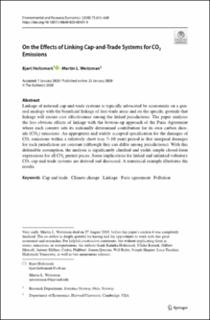| dc.contributor.author | Holtsmark, Bjart | |
| dc.contributor.author | Weitzman, Martin L. | |
| dc.date.accessioned | 2020-04-23T16:37:50Z | |
| dc.date.available | 2020-04-23T16:37:50Z | |
| dc.date.created | 2020-01-24T14:22:08Z | |
| dc.date.issued | 2020-01-23 | |
| dc.identifier.citation | Holtsmark, B., Weitzman, M.L. On the Effects of Linking Cap-and-Trade Systems for CO2 Emissions. Environmental Resource Economics 75, 615–630 (2020). | en_US |
| dc.identifier.issn | 0924-6460 | |
| dc.identifier.uri | https://hdl.handle.net/11250/2652263 | |
| dc.description.abstract | Linkage of national cap-and-trade systems is typically advocated by economists on a general analogy with the beneficial linkage of free-trade areas and on the specific grounds that linkage will ensure cost effectiveness among the linked jurisdictions. The paper analyses the less obvious effects of linkage with the bottom-up approach of the Paris Agreement where each country sets its nationally determined contribution for its own carbon dioxide ( CO 2) emissions. An appropriate and widely accepted specification for the damages of CO 2 emissions within a relatively short (say 5-10 year) period is that marginal damages for each jurisdiction are constant (although they can differ among jurisdictions). With this defensible assumption, the analysis is significantly clarified and yields simple closed-form expressions for all CO 2 permit prices. Some implications for linked and unlinked voluntary CO 2 cap-and-trade systems are derived and discussed. A numerical example illustrates the results. | en_US |
| dc.language.iso | eng | en_US |
| dc.publisher | Springer | en_US |
| dc.rights | Navngivelse-Ikkekommersiell-DelPåSammeVilkår 4.0 Internasjonal | * |
| dc.rights.uri | http://creativecommons.org/licenses/by-nc-sa/4.0/deed.no | * |
| dc.subject | Climate change | en_US |
| dc.subject | Pollution | en_US |
| dc.subject | Klimaendringer | en_US |
| dc.subject | Cap and trade | en_US |
| dc.subject | Kvotehandelssystemer | en_US |
| dc.subject | Klimagasser | en_US |
| dc.title | On the Effects of Linking Cap‑and‑Trade Systems for CO2 Emissions | en_US |
| dc.type | Peer reviewed | en_US |
| dc.type | Journal article | en_US |
| dc.description.version | publishedVersion | en_US |
| dc.rights.holder | Open Access. This article is licensed under a Creative Commons Attribution 4.0 International License, which permits use, sharing, adaptation, distribution and reproduction in any medium or format, as long as you give appropriate credit to the original author(s) and the source, provide a link to the Creative Commons licence, and indicate if changes were made. | en_US |
| dc.subject.nsi | VDP::Samfunnsvitenskap: 200::Økonomi: 210 | en_US |
| dc.source.pagenumber | 615–630 | en_US |
| dc.source.volume | 75 | en_US |
| dc.source.journal | Environmental and Resource Economics | en_US |
| dc.source.issue | March | en_US |
| dc.identifier.doi | 10.1007/s10640-020-00401-8 | |
| dc.identifier.cristin | 1781668 | |
| dc.relation.project | Norges forskningsråd: 209698 | en_US |
| cristin.ispublished | true | |
| cristin.fulltext | original | |
| cristin.qualitycode | 1 | |

